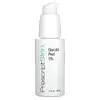What's inside
What's inside
 Key Ingredients
Key Ingredients

 Benefits
Benefits

 Concerns
Concerns

 Ingredients Side-by-side
Ingredients Side-by-side

Water
Skin ConditioningCyclopentasiloxane
EmollientCarthamus Tinctorius Seed Oil
MaskingGlycerin
HumectantPropylene Glycol
HumectantSimmondsia Chinensis Seed Oil
EmollientLeuconostoc/Radish Root Ferment Filtrate
AntimicrobialPEG/PPG-18/18 Dimethicone
EmulsifyingCarbomer
Emulsion StabilisingXanthan Gum
EmulsifyingBenzyl Alcohol
PerfumingSodium Hydroxide
BufferingAloe Barbadensis Leaf Juice
Skin ConditioningCaprylic/Capric Triglyceride
MaskingPEG-8
HumectantSodium Gluconate
Skin ConditioningAllantoin
Skin ConditioningCaprylhydroxamic Acid
Cetearyl Alcohol
EmollientPunica Granatum Extract
AstringentCitrus Limon Peel Oil
MaskingVitis Vinifera Seed Extract
AntimicrobialStearic Acid
CleansingCetyl Alcohol
EmollientPhenoxyethanol
PreservativeDicaprylyl Ether
EmollientSqualane
EmollientAloe Barbadensis Leaf Juice Powder
Skin ConditioningMagnesium Aluminum Silicate
AbsorbentPolysorbate 60
EmulsifyingCitrus Aurantium Dulcis Flower Oil
AstringentPEG-150 Stearate
Polysorbate 80
EmulsifyingEthylhexylglycerin
Skin ConditioningO-Cymen-5-Ol
AntimicrobialCeteareth-20
CleansingPEG-20 Hydrogenated Lanolin
EmollientPEG-40 Stearate
EmulsifyingFructooligosaccharides
HumectantGlucosamine Hcl
Citric Acid
BufferingWater, Cyclopentasiloxane, Carthamus Tinctorius Seed Oil, Glycerin, Propylene Glycol, Simmondsia Chinensis Seed Oil, Leuconostoc/Radish Root Ferment Filtrate, PEG/PPG-18/18 Dimethicone, Carbomer, Xanthan Gum, Benzyl Alcohol, Sodium Hydroxide, Aloe Barbadensis Leaf Juice, Caprylic/Capric Triglyceride, PEG-8, Sodium Gluconate, Allantoin, Caprylhydroxamic Acid, Cetearyl Alcohol, Punica Granatum Extract, Citrus Limon Peel Oil, Vitis Vinifera Seed Extract, Stearic Acid, Cetyl Alcohol, Phenoxyethanol, Dicaprylyl Ether, Squalane, Aloe Barbadensis Leaf Juice Powder, Magnesium Aluminum Silicate, Polysorbate 60, Citrus Aurantium Dulcis Flower Oil, PEG-150 Stearate, Polysorbate 80, Ethylhexylglycerin, O-Cymen-5-Ol, Ceteareth-20, PEG-20 Hydrogenated Lanolin, PEG-40 Stearate, Fructooligosaccharides, Glucosamine Hcl, Citric Acid
 Reviews
Reviews

Ingredients Explained
These ingredients are found in both products.
Ingredients higher up in an ingredient list are typically present in a larger amount.
Allantoin is a soothing ingredient known for its protective and moisturizingg properties. Because of this, it is often added to products with strong active ingredients.
Studies show higher concentrations of this ingredient can promote wound healing.
Though it can be derived from the comfrey plant, allantoin is produced synthetically for cosmetic products to ensure purity.
Learn more about AllantoinBenzyl Alcohol is most commonly used as a preservative. It also has a subtle, sweet smell. Small amounts of Benzyl Alcohol is not irritating and safe to use in skincare products. Most Benzyl Alcohol is derived from fruits such as apricots.
Benzyl Alcohol has both antibacterial and antioxidant properties. These properties help lengthen the shelf life of products. Benzyl Alcohol is a solvent and helps dissolve other ingredients. It can also improve the texture and spreadability.
Alcohol comes in many different forms. Different types of alcohol will have different effects on skin. This ingredient is an astringent alcohol.
Using high concentrations of these alcohols are drying on the skin. They may strip away your skin's natural oils and even damage your skin barrier. Astringent alcohols may also irritate skin.
Other types of astringent alcohols include:
According to the National Rosacea Society based in the US, you should be mindful of products with these alcohols in the top half of ingredients.
Any type of sanitizing product will have high amounts of alcohol to help kill bacteria and viruses.
Learn more about Benzyl AlcoholGlycerin is already naturally found in your skin. It helps moisturize and protect your skin.
A study from 2016 found glycerin to be more effective as a humectant than AHAs and hyaluronic acid.
As a humectant, it helps the skin stay hydrated by pulling moisture to your skin. The low molecular weight of glycerin allows it to pull moisture into the deeper layers of your skin.
Hydrated skin improves your skin barrier; Your skin barrier helps protect against irritants and bacteria.
Glycerin has also been found to have antimicrobial and antiviral properties. Due to these properties, glycerin is often used in wound and burn treatments.
In cosmetics, glycerin is usually derived from plants such as soybean or palm. However, it can also be sourced from animals, such as tallow or animal fat.
This ingredient is organic, colorless, odorless, and non-toxic.
Glycerin is the name for this ingredient in American English. British English uses Glycerol/Glycerine.
Learn more about GlycerinSodium Hydroxide is also known as lye or caustic soda. It is used to adjust the pH of products; many ingredients require a specific pH to be effective.
In small amounts, sodium hydroxide is considered safe to use. However, large amounts may cause chemical burns due to its high alkaline.
Your skin has a natural pH and acid mantle. This acid mantle helps prevent harmful bacteria from breaking through. The acid mantle also helps keep your skin hydrated.
"Alkaline" refers to a high pH level. A low pH level would be considered acidic.
Learn more about Sodium HydroxideWater. It's the most common cosmetic ingredient of all. You'll usually see it at the top of ingredient lists, meaning that it makes up the largest part of the product.
So why is it so popular? Water most often acts as a solvent - this means that it helps dissolve other ingredients into the formulation.
You'll also recognize water as that liquid we all need to stay alive. If you see this, drink a glass of water. Stay hydrated!
Learn more about Water